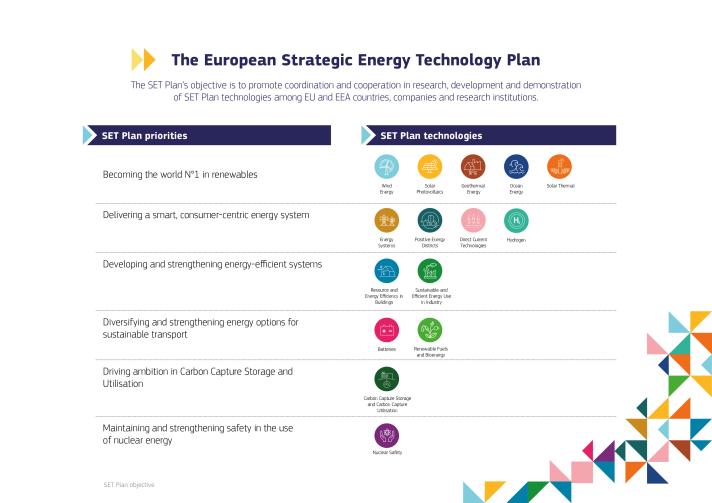Shaping the EU's energy and climate policy
The Strategic Energy Technology (SET) Plan, launched by the European Commission in 2007, is a first step toward establishing an energy technology policy for Europe. It is the main decision-making support tool for European energy policy, with a goal of:
- implementing the research, innovation and competitiveness aspect of the Energy Union
- guiding national energy research strategies, as outlined in the National Energy and Climate Plans (NECPs)
- accelerating knowledge development, technology transfer and uptake
- maintaining EU industrial leadership on low-carbon energy technologies
- supporting the transformation of energy systems to meet the EU’s 2030 and 2050 climate and energy targets
- contributing to the global transition to a low-carbon economy by 2050.

In 2023, the European Commission adopted a Communication on the revision of the SET Plan to enhance the SET Plan’s support for the European Green Deal and the European Research Area.
A series of communications in 2006, 2007, and 2009:
- introduced the SET Plan concept
- launched the Plan
- defined its financial requirements and implementation strategy.
In 2013, a fourth Communication reinforced the SET Plan’s implementation structure, strengthening its position as the key framework for energy research and innovation under the Horizon 2020 Framework Programme.
The 2015 Communication on the integrated SET Plan connected the SET Plan to the fifth dimension of Europe’s energy system, i.e. ‘Research, innovation and competitiveness’.
The initial 10 key actions of the SET Plan addressed the EU’s energy R&I priorities to accelerate the transformation of the energy system, as outlined in the 2015 Energy Union Communication. Progress on these actions was included in the annual report to the European Parliament and the Council on the ‘State of the Energy Union’.
The Declarations of Intent were adopted in 2016. These documents serve as formal agreements between the European Commission, the SET Plan countries and key stakeholders to establish a new working group within the SET Plan.
The initial 14 IPs were drafted to cover the 2015 Energy Union R&I priority areas according to the 10 key actions. These plans outline activities and actions – identified in cooperation with the SET Plan countries and stakeholders (industry and research bodies) – to be carried out at regional, national and European level.
The first IWGs, formed in cooperation with the SET Plan countries and relevant industry and research stakeholders, carry out the R&I activities presented in the IPs and monitor their progress.
2018 – Agenda 2018-2023
The SET Plan’s agenda for 2018–2023 outlined the necessary tasks to achieve its objectives by implementing the 10 key actions. The agenda builds on the 2015 Commission Communication ‘Towards an Integrated Strategic Energy Technology Plan’.
The first SET Plan progress monitoring report was published in 2020. It was released during the 13th SET Plan conference in Helsinki, Finland and offers a concise overview based on inputs from the SET Plan IWGs.
In 2020, the IWGs on energy consumers and energy systems were merged to:
- address organisational overlap
- increase efficiency in achieving the SET Plan priorities
- highlight the important role consumers will play in the future energy system.
The second SET Plan progress monitoring report was published, in the context of the European Green Deal. The progress report was released at the 14th SET Plan conference in Berlin, Germany. `
In 2021, the SET Plan High voltage direct current (HVDC) & direct current (DC) technologies working group was established to identify the needs and pathways for developing and deploying HVDC and DC technologies in the EU.
The SET Plan report on ‘Contributing to the EU Green Deal and the path forward to a green recovery’ was published in November 2021. It features three interconnected chapters that discuss the political relevance of the SET Plan, developments over the past year and a concise overview of the IWGs’ achievements.
On 20 October 2023, the European Commission adopted a Communication on the revision of the SET Plan. The Communication aims to align the original SET Plan strategic objectives with the European Green Deal, REPowerEU and the Green Deal Industrial Plan, whose building blocks are the Net-Zero Industry Act and the Critical Raw Materials Act. It ensures a unified approach to achieving Europe’s decarbonisation goals, supporting strategic net-zero energy technologies, and building a sustainable and resilient energy future.
Under the revised SET Plan, the Net-Zero Industry Act (NZIA) came into force on 29 June 2024 with the aim to boost the EU’s domestic manufacturing of clean energy technologies. As such, the SET Plan Steering Group is formally established as a high-level expert group to the European institutions. Composed of Member States and Commission representatives, and with EEA observers, it will oversee alignment of energy R&I programmes and advise on strategic actions.
In line with the SET Plan revision and the 2023 SET Plan Communication, five SET Plan task forces (TFs) were officially established in 2024. They will support the work of the SET Plan Implementation Working Groups and ETIPs, addressing cross-cutting challenges in clean energy R&I at the European level.
The new Temporary Working Group on hydrogen focuses on two main activities: transitioning new hydrogen technologies from R&I to market uptake and incorporating hydrogen into the energy mix to boost clean energy efficiency. Additionally, the new hydrogen working group addresses legislative issues such as the temporal and geographical correlation in the revision of the Renewable Energy Directive.
For more information, please see this European Commission press
